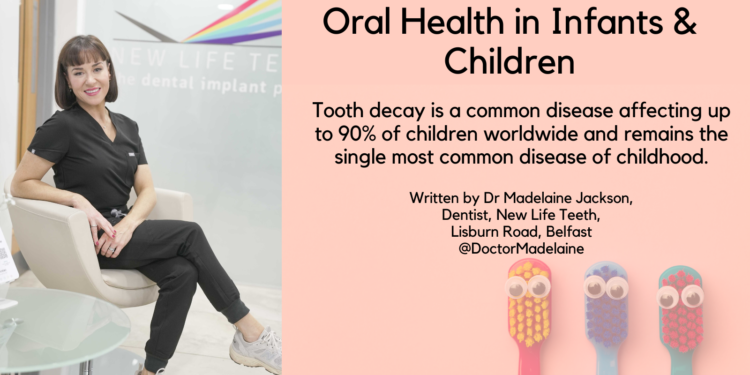As a Mum of two children aged 6 and 8, oral healthcare is of paramount importance. For my children to understand the importance of healthy teeth is valuable knowledge they are learning for all their lives. Away from the dental practice I have been able to spend time with my children’s other classmates at school to educate on the same topic. The kids are always super responsive to the facts and learnings I teach. Free toothbrushes, toothpaste also helps in getting their attention.
Tooth decay is a common disease affecting up to 90% of children worldwide and remains the single most common disease of childhood. It impacts on quality of life and can be the reason for thousands of children needing dental treatment under general anaesthetic in hospital. However, it can easily be prevented by good oral health habits such as brushing teeth regularly with toothpaste that contains fluoride and cutting down on sugary food and drinks. If left undisturbed, the unhelpful bacteria in the mouth- which cause decaymultiply and stick to the surfaces of teeth producing a sticky film. Then when sugar is eaten or drank, the bad bacteria in the film make acid resulting in tooth decay. Promoting oral health in the early years is essential to protecting young teeth and establishing good habits. Children need to form good oral habits from an early age to help avoid tooth decay.
There are three main themes in good dental health:
• Limit frequency of and keep sugary and acidic food and drinks to mealtimes
• Brush teeth at least twice a day with a fluoride toothpaste
• Visit the dentist regularly If appropriate measures are applied early enough, it is possible to prevent dental disease.
Dental caries
Enamel is made up of calcium and phosphorus minerals. When the mouth becomes too acidic, it begins to pull these minerals out of the teeth. This process is called ‘demineralisation’. Tooth demineralisation is caused by acids excreted by bacteria as a product of their metabolism of sugar or acidic foods. A diet high in sugars supports an acidic environment promoting demineralisation of dental enamel; if this continues deeper into the tooth it can eventually lead to a cavity (dental caries). Saliva acts as a natural buffer; it contains calcium and phosphorus and bathes our teeth to replace these lost minerals. This process is called ‘remineralisation’. Early cavities that are just beginning to form can be reversed through remineralisation.
Onset of dental caries
By the age of 12 months, infants begin to establish an oral environment that places them at risk of dental caries. Breastfeeding up to 12 months of age is associated with a decreased risk of tooth decay, whilst prolonged bottle feeding, can provide an oral environment ideal for decay producing bacteria to proliferate. Streptococcus mutans, implicated as the principal bacteria responsible for the initiation of dental caries, is acquired by infants primarily from their mother.
Fluoride
Fluoride acts to bring calcium and phosphate ions together, making the teeth resistant to demineralisation, at the same time enhancing enamel remineralisation. Topical fluoride in toothpastes, mouthwash and professionally applied varnish are highly effective in increasing resistance of children’s teeth to dental caries.
Special care needs
Children with special care may have special dental needs. They have a higher susceptibility to gum disease, dental caries, and oral trauma. Extra care and support must be taken to prevent dental caries, infection, and other problems among these children.
Promoting good oral care at home
Oral health and nutrition are essential for the proper growth and development of children. Parents and caregivers often receive little guidance about oral health care and prevention, including fluoride and nutrition.
To promote good oral health in infancy caregivers should provide the correct amounts of fluoride alongside a healthy diet. It important to limit amount and frequency of sugary foods and drinks and avoid sugar-containing foods and drinks at bedtime when saliva flow is reduced, and buffering capacity is reduced.
To reduce the incidence of dental caries, parents and other caregivers should be educated about proper feeding practices during infancy and the preschool years. Preventative oral strategies and education should begin with the mother before birth and continue throughout infancy and childhood. Support mothers who breastfeed, to do so exclusively for the first 6 months, breastfed babies experience less tooth decay. For parents and carers feeding babies by bottle only breastmilk, formula or cooled boiled water should be given in a bottle. Babies should be introduced to drinking from a free flow cup at 6 months of age and bottles discouraged from 1 year. Specific recommendations include elimination of a bottle in bed, early use of soft bristled toothbrushes with parental supervision and limitation of sugar after the teeth have been brushed.
Toothbrushing should begin when the first tooth erupts, with a soft bristled toothbrush and a tiny amount of fluoride toothpaste. Brush last thing at night and one other time of day. Children 3-6 years should apply a pea size amount. Toothbrushing should be supervised until at least 7 years of age. Each child should attend the dentist by no later than 12 months of age.
In early infancy 0-6 months, although the teeth have yet to erupt, the teeth and jaw are developing rapidly. Thumb sucking and pacifiers may cause problems with tooth alignment and jaw development at this stage. Future and new possibilities include xylitol wipes, antibacterial against streptococcus mutans, tested for cleaning babies’ gums and erupting teeth, show some promise as an intervention in preventing caries.
Finally, there are still some inconsistencies and grey areas to be resolved in defining, labelling, and marketing ‘no added sugar’ food and drinks, containing concentrated amounts of natural and free sugars that adversely impact children’s’ teeth.










